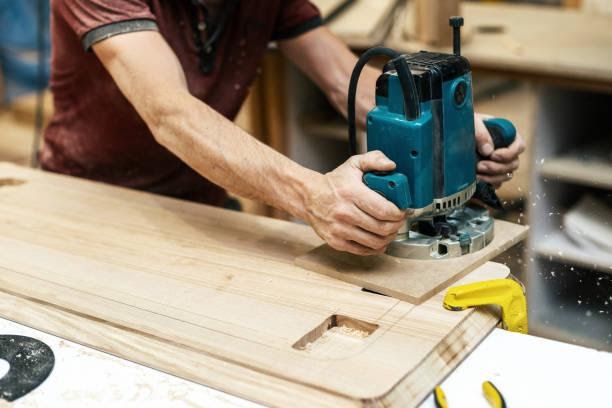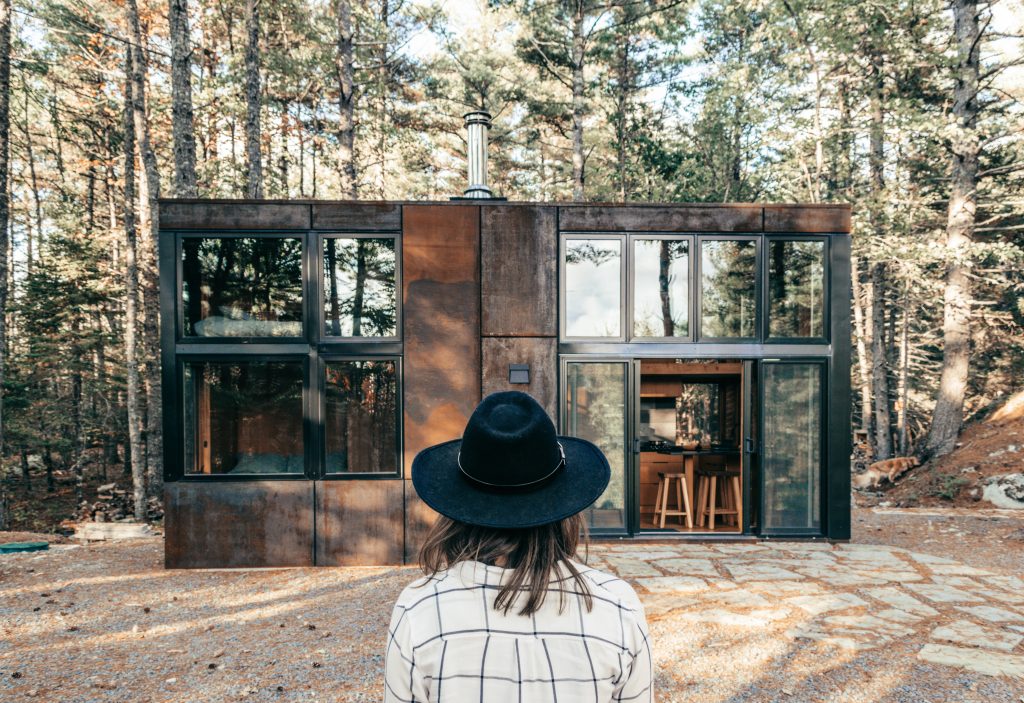
Building Your Wood workshop! What would be the first thing that will come to your mind when you hear those words?
This article will help you learn tips and tricks on how to layout your woodworking shop at home, and start your woodworking project in your workshop.
What would make a good woodworking shop?
Contents
- 1 Woodworking Workshop Project
- 2 How Do You Make A Woodworking Workshop?
- 3 Woodworking Workshop: Step-By-Step Guide
- 4 What Does It Cost To Build A Workshop?
- 5 Is Dust Collection System Important In A Woodworking Workshop?
- 6 Woodworking Shop Light Fixtures
- 7 Wood Workshop Hand Tools And Its Usage
- 8 Wood Workshop Power Tools And Its Usage
- 9 Wood Workshop Space-Saving Tricks
Woodworking Workshop Project
What is a woodworking shop? A woodworking shop is a space or one room designated for woodworking. It is a work area where a woodworker works and stores his/her wood projects, tools, and equipment like a workbench, lumber, and cabinet. It contains the following:
Wood Workshop Hand Tools
- Jack Plane & Block Plane
- Panel Saws & Back Saws
- Miter Box and Miter Saw
- Coping Saw & Bench Chisel Set
- Mortise Chisel
- Combination & Try Square
- Sliding Bevel Square
- Dividers (Compass)
- Marking Gauge
- Folding Rule and Tape Measure
- Marking Knife
- Sharpening Supplies
- Wooden Joiners Mallet
- Rabbet Plane
- Woodworking Clamps
Wood Workshop Power Tools
- Circular Saw
- Drill
- Jigsaw
- Random Orbit Sander
- Table Saw
- Compound Miter Saw
- Router
A good wood workshop needs to have enough tool storage, a good working ambiance, woodworking task lighting like a desk lamp and a floor lamp, and good ventilation. It is also important to consider approved electrical requirements like electrical plug and outlets, noise reduction equipment, and proper safety precaution equipment.
Moreover, a working shop must have a wood storage area, a working workbench, tool cabinets, a machine area, and a finishing area. Make sure that your work area had enough space for you to move around freely. It is also important to have an opening for long, extended boards and lumber.
How Do You Make A Woodworking Workshop?
An extravagant woodworking shop is not important. You can choose to build a simple platform and a precise work area to conveniently and safely carry on your woodworking projects, whether it is just a small shop or a tool shed outside your house, a small room in your garage, or a small work area in your basement. Yes, you can build your woodworking shop right in your own house with the right preparation and workshop materials.
You need to:
- Plan
- Prepare
- Implement
Woodworking Workshop: Step-By-Step Guide
1. Planning
Before building your projects, you need to have a plan. Plan everything for your shop, and make sure to implement what you plan for your projects.
The first thing you need to do is defining your workspace. Ask yourself:
- Where would I want to layout my woodworking workshop?
- Is it better to make it inside or outside my house?
- Where would it best suited – in my home basement or my home garage?
- How big or small shop can I afford to build?
- How much money would I need to make my home woodworking shop?
- If I will build it inside my home basement or home garage, How can I ensure my family’s safety?
- What would be my woodworking shop design?
- How about my woodworking shop floor design?
- Ask yourself how often you will be in your workshop?
By answering those questions, you can now create your woodworking workshop blueprint and layout your shop design.
Woodworking Workshop Layout
Take some time to draw and sketch out your planned workshop. You can either draw it on plain paper or graphing paper. Draw a plan for your garage woodshop. Or draw a plan for your basement wood shop. Wherever it is, just make sure to draw your workshop layout. Scale-out every space and measurement you want to have in your shop. Draw and scale how big will be your shop door, your floor plan, your ceiling, your wall space, and your windows, if appropriate, to have on your shop. Now imagine that you already had the layout and shop design.
What’s next?
The second thing you need to plan is the woodworking tools for your shop projects. List everything you need for your woodworking workshop.
Think about:
- What will be the new tools you may need for your shop
- What will be the biggest tools you need
- Where to place your woodworking tools and equipment
- What kind of bench you will have in your garage shop
- Would it be better to have a portable bench
- Will be better to have a compact bench in your garage shop
You can create one list for your workshop tools and accessories and one for the workshop equipment.

For a complete list of woodworking tools for a workshop, check this checklist here:
Wood Workshop Tools
- Table saws
- Bandsaw
- Hand saws
- Jack & Block Plane
- Joining & Rabbet Plane
- Scraper Plane
- Spokeshaves
- Orbital Sanders
- Hand Files
- Hammer
- Mallet
- Drill
- Screw Gun
- Tape Measure
- Retractable Steel Tapes
- Flexible Reel Tapes
- Folding Ruler
- Yardsticks and Straight Edges Ruler
- Framing Square
- Try Squares
- Combination Squares
- Speed Squares
- Miter Squares
- Bevel Squares
- Sawhorses
- Workbench
- Circular saw
- Jigsaws
- Compound Miter Saws
- Radial Arm Saw
Wood Workshop Equipment & Components
- Space Saver Cabinet
- Storage For Hand tools
- Pegboard
- Gear Cabinet
- Shelving Storage for Woodworking Tools and Materials
- Lights & Woodworking Lighting
- Electrical Outlets
- Box Fan For Ventilation
- Duct Collector for Dust collection
- Fire Extinguisher
Now, you had everything you need for your woodworking shop tools. What’s next?
2. Preparation
What are the things that you need to prepare for a workshop? You can refer to the lists you created and the shop layout you designed. Prepare everything you need from your shop layout materials, like lumber, nails, screws, and roof. Prepare all the tools you need in making a layout for your woodworking shop. Also, prepare all the working tools and equipment that you need for your shop before setting up your workshop. But the most important thing you need to do is to prepare your shop workspace.
3.Implementation
Make a comparison. If you had plans to create your backyard workshop, think about the pros and cons of making it in your house garage or even in your basement. Whether you are building your woodworking shop in your backyard, in your garage area, or your basement, you need to properly prepare your shop workspace. But how?
Woodworking Workshop Layout On Backyard
If you had plans to create your workshop outside your home, you will more likely start from the very basic. Maybe you need to start by compacting your backyard soil and leveling each block. You can then start building your backyard shop by laying out the floor plans and the building itself. But, do make sure that your workshop was high enough from the ground to avoid flooding.
Woodworking Workshop Layout On Garage and Basement
Building your woodworking shop in your home garage or your basement may not be that difficult as building in your home backyard. You don’t have to start from the basics, but you still need to prepare your workspace. Start from cleaning your garage by removing unnecessary things and equipment. After that, you can start implementing your shop layout from your floor, wall design, ceiling, and roof. Start nailing and setting your shop with proper tools and safety precautions. Just don’t forget to follow your shop layout and design.
What Does It Cost To Build A Workshop?
Building your woodworking shop will not only cost you a dollar. It will cost you time and your strength.
How much does it cost to build a woodworking workshop?
Woodworking workshop building costs will depend on how big your shop is. It also depends on how expensive the materials you bought and the human resources and construction labor cost. Additional costs will add up for the materials delivery cost. For a complete checklist, read here:
Workshop Building Cost Checklist
- Materials Cost
- Labor & Human Resources
- Delivery Cost
- Heating & Ventilation Cost
- Lighting & Electricity Cost
- Safety Equipment Cost
- Maintenance Cost
- Working Tools Cost
- Woodworking Machines Cost
- Woodworking Accessories Cost
With the checklist above, you can have the approximate amount you need for your woodworking shop projects.
What is a good size for a wood workshop?
The size of a wood workshop differs in how you used your shop. Are you planning to build a workshop and used it as a commercial shop or a storefront? Then you need to make it bigger than the usual shop in a garage and a basement. However, if you are thinking of building a wood workshop just for your personal use, then even a small space in your garage or the basement is enough.

What is the size of a workshop?
When deciding on how big or small your woodworking workshop would be, consider these two things:
First, If you will use your workshop primarily for personal woodworking, its minimum recommended size from experienced woodworkers will be around 75 square feet.
Second, If you will use your workshop commercially, its recommended size will be 125 square feet. Why such a big workshop? It is recommended to have a lumber storage area within your workshop space.
However, your woodworking shop size will be determined by the number of woodworking tools, woodworking machines, and accessories you will have in your very own workshop.
For example, if you had plans to have a fixed workbench with a stationary radial arm saw, a drill press with a compact stand, an operating table saw, a miter saw with a compact frame, heavy-working and woodworking machines. Additionally, if you plan to bring in large-sized lumber, sheet goods like plyboard and plywood, you plan to create a big woodworking project. Then you may need a big workshop at all. A workshop in your garage will not be enough space for such a woodworking project.
Yes, your workshop size matters depending on your woodworking project. It is one factor that affects how good your woodworking workshop is. But that’s not all you need for a good woodworking workshop. A proper dust collection system in your workshop is essential for a good woodworking shop.
Is Dust Collection System Important In A Woodworking Workshop?
Definitely, Yes! Why? Because the wood dust collector in your workshop will ensure your safety from potential risk in your workshop. It will prevent any health problems related to woodworking like skin irritation caused by wood dust, respiratory issues like asthma, and chronic bronchitis. Breathing with a speck of wood dust may result in severe allergic reactions to your skin and respiratory system.
To read more about dust collection system, you can read here.
How To Prevent Wood Dust In A Woodworking Workshop
Prevent wood dust in your workshop with a strict cleaning schedule and an appropriate dust collection system. Your dust collector will gather the dust from your workshop, prevent health problems, and help you avoid safety risks. It will also help you keep your woodworking workshop clean and free from airborne dust.
What Would Be The Best Dust Collector I Can Use For My Workshop?
There are different types of dust collection systems from the various brands available in the marketplace. For example, if you will look for a duct collector on Amazon, you can find branded dust collector like:
- Wen Dust Collector
- Shop Fox Dust Collector
- Powertec Dust Collector
- Dewalt Dust Collector
- Jet Dust Collector
- Oneida Air Dust Collector
- Powermatic Dust Collector
- Grizzly Dust Collector
- Bucktool Dust Collector
- Rikon Dust Collector
Each dust collector is labeled as the best dust collector for a woodworking workshop. But how can you choose the best dust collector for your workshop?
Best Dust Collection System For Your Workshop
When choosing the suitable dust collector for your woodworking workshop, it is important to remember that it’s not just between selecting the right brand or the correct dust collector model.
You need to consider the following factors:
- Woodworking Workshop Size
- Motor Power
- Horsepower
- Dust Collector Capacity
With the assessment of your workshop layout and your workshop production process, you can decide on the best dust collector for your workshop.
However, if you have a hard time deciding on what dust collector you should have in your workshop, you can ask for help from a dust collection system specialist. They can help you choose and design the most effective and cost-efficient one.
Aside from a proper dust collector in your workshop, it is also important to have a good ambiance.
Woodworking Shop Light Fixtures
Good light fixtures on your workshop will add its ambiance. Woodworking tasks require accurate measurements and precise tool set-up. Thus, insufficient lighting in your workshop will not only hinder your vision. It will also affect the quality of your work and workpiece. Working in a dim and shadowy work area using a power tool and woodworking machines will result in safety hazards.
Your workshop must have good lighting equipment. Check out these two types of workshop lighting:
- Ambient Lighting – It is an overall light illumination in your workshop. It ensures a comfortable and safe workshop.
- Task Lighting – It is an additional light for your ambient lighting. It focuses on your area of work where you need to work with accuracy and precision. For example, if you are doing hand-cutting joinery or carving on your workpiece, lighting is necessary.
It is also important to avoid insufficient light ambiance in your working area. Avoid hindering your vision as you work with your project for better woodworking results.
Done with the workshop layout?
Then start filling up your shop with your working tools and machines!
Wood Workshop Hand Tools And Its Usage
Measurement
- Tape Measure – It comes in a variety of lengths, from 12 feet to 33 feet. It is used to simplify woodworking measurements for exact measurements.
- Long Tape – It measures from 100 feet or more and is used for measuring building structures and objects that are more than 33 feet.
- Speed Square – It is a measuring tool used for marking and measuring angles in woodworking and carpentry. Whether you measure in 45-degree or 90-degree angles, it will be an absolute necessity in your workshop.
- Leveller – It is widely used in woodworking to make an exact level in woodworking projects. It has a straight edge and a liquid-filled small container that contain a bubble that will mark the precise level. However, a high-tech leveler instead of a liquid-filled small round container uses a laser beam to keep the exact measurement.
Drills
Cordless Power Drill – It is a portable woodworking tool used in a workshop. It is used in drilling a wide variety of woodworking materials.
Cutting
The following hand tool is used in cutting sheet metal and other essential materials in your woodworking projects.
- Aviation Snips
- Utility Knives
- Scissors
Hand Saws
There are different types of hand saw that you need in your woodworking workshop. It includes the following:
- Cross-Cut Saw
- Coping Saw
- Keyhole Saw
- Compass Saw
- Pull Saw
Hammers
Different types of hammers are essential to your workshop includes:
- Tack Hammer
- Nailing Hammer
- Dead-Blow Hammer
- Mallets
Wrench
Different types of wrenches are useful in woodworking projects. They are used in a wide variety of woodworking works like tightening a screw or adjusting a bolt on a wood. Different types of wrenches are the following:
- Adjustable Wrench
- Open-Ended Wrench
- Box Wrench
- Combination wrench
Aside from the hand tools mentioned above, it is also necessary that you have a plier, a chisel, files, rasps, and a hand plane in your workshop.
Wood Workshop Power Tools And Its Usage
Drill
Corded Power Drill – It is a woodworking tool attached to the main power source for you to use it. It may limit your movements around your workshop, but it is much better when it comes to power strength and torque.
Circular Saw
It is one of the handheld power tools that you should have in your workshop. Just like the table saw, it can cut accurately with different woodworking materials. It can cut sheet goods like plywood and fiberboard with accuracy.
Other woodworkers use a circular saw in cutting thick chunk lumber and rough cutting wood boards instead of using a table saw.
Table Saw
It is known to be the centerpiece in a woodworking shop. A table saw is used to cut sheet goods perfectly with a straight edge. A table saw in your shop can be used to organize your woodworking shop tools. It can make a cut whatever you want it to be. It includes a miter saw cutting, bevels, and dado grooves.
Miter Saw
It is an inexpensive yet valuable power tool you should have in your workshop. A miter saw is used for angle cutting, beveled cutting, mitered cutting, and even a compound cut. Miter saw will allow you to cut a straight angle on your woodwork.
Jigsaw
You can use a jigsaw to create a curved and circular cutting on your workpiece. It is widely used among beginner woodworkers as it is easy to use.
Sander
It is a handheld power tool used in sand woodworking projects to make it soft to touch.
Routers
Routers are commonly used to create a decorative contour on your woodwork. It has two types, the standard router, and the plunge router. They are both useful in a woodworking shop in a different way.
For example, you can use the standard router to remove a specific wood contour from the edges of a piece of lumber. In comparison, the plunge router is best used to remove woodworking contour from the middle of a lumber piece precisely. It is an excellent tool used for rabbets and dado cutting.
Aside from the power tools mentioned above, a radial arm saw, biscuit joiners, planers, drill press, wood lathes, joiners, molders, and shapers are also essential in your shop.

Best Woodworking Power Tool Brands In The Market
- Milwaukee
- Porter
- Powermatic
- Ridgid
- Rockwell
- Ryobi
- Skil
- DeWalt
- Dremel
- Festool
- Grizzly
- Hitachi
- Jet
- Makita
- Black & Decker
- Bosch
- Bostitch
- Craftsman
- Delta
Don’t have enough space in your shop for all these woodworking new tools and accessories? That’s not a problem.
Wood Workshop Space-Saving Tricks
- Wall Mounted Storage– Start to save space on your shop by making a hanging tool shed and wall mounted cabinet for your tools. With your Screw Gun, screw some hooks on your wall space. It can be used as a space-saver storage hook for your hanging devices.
- Folding Work Bench – Not all woodworking projects require the use of a workbench. By setting a DIY folding workbench, you can have a more convenient and comfortable work area. By folding your workbench, you can instantly save space on your floor and use other workshop tools.
- Shelving Storage – Setting shelf storage on your wall between studs. You can use it to store smaller working tools and save some space in your shop.
- Ceiling Storage – Save some floor space in your shop by installing some slats on your ceiling and using them as storage for your tools. Your woodworking devices must be easy to reach and are accessible.
- Round Storage Container – Save time and space by setting a round storage container from angled PVC and mount it on your board. Used it as storage for your small tools like pen, pencil, screws, bolts, and other small items that are easy to lose in your shop.
- Pegboard – Installing a pegboard on your wall will help you organized your woodworking materials, accessories, and small equipment.

It’s not about how big or small your workshop will be. It is about how good it is. How comfortable it is for you as your woodworking space. Just make sure that your woodworking workshop surfaces are even and you have the basic tools required. Start with the very basic.
Learn woodworking basics that you should know as a beginner before setting up your workshop.
Start setting your wood workshop layout today!
